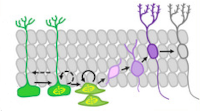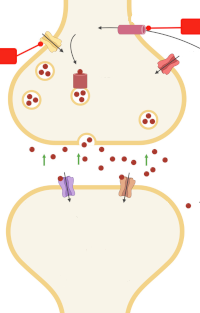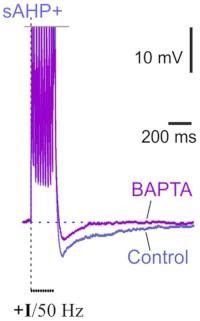Learning and memory
-
Временная и пространственная информация вызывает различные профили мощности и подключения во время обслуживания рабочей памяти.
 Группа ученых из НИУ ВШЭ провела эксперимент для изучения деталей нейрональных механизмов обработки и хранения данных о времени и пространстве в рабочей памяти. Эксперимент показал, что оперировать временем сложнее, чем пространством. Работа опубликована в Journal of Cognitive Neuroscience.«Количество и интенсивность колебаний нейрональной активности в бета-диапазоне частот оказались более выраженными в теменной доле, что может указывать на перевод временной информации в пространственную форму. Мы предполагаем, что концепт времени настолько сложен, что человеческому мозгу требуются дополнительные пространственные “маяки” для обработки информации о времени в рабочей памяти«, — комментирует работу Никита Отставнов, младший научный сотрудник Международной лаборатории социальной нейробиологии Института когнитивных нейронаук НИУ ВШЭ.
Группа ученых из НИУ ВШЭ провела эксперимент для изучения деталей нейрональных механизмов обработки и хранения данных о времени и пространстве в рабочей памяти. Эксперимент показал, что оперировать временем сложнее, чем пространством. Работа опубликована в Journal of Cognitive Neuroscience.«Количество и интенсивность колебаний нейрональной активности в бета-диапазоне частот оказались более выраженными в теменной доле, что может указывать на перевод временной информации в пространственную форму. Мы предполагаем, что концепт времени настолько сложен, что человеческому мозгу требуются дополнительные пространственные “маяки” для обработки информации о времени в рабочей памяти«, — комментирует работу Никита Отставнов, младший научный сотрудник Международной лаборатории социальной нейробиологии Института когнитивных нейронаук НИУ ВШЭ. -
Клеточные и молекулярные основы обучения и памяти (в пространстве и времени)

Научный руководитель Института высшей нервной деятельности и нейрофизиологии РАН академик Павел Милославович Балабан рассказал о переосмыслении роли глиальных клеток в работе мозга и о новых проектах российских ученых. Среди новых проектов, разработанных совместно с коллегами из различных научных институтов и уже готовых к внедрению ― вирусный препарат, снимающий эпилепсию в любой части мозга, нейрогенетическое протезирование дегенеративной сетчатки и избирательное стирание памяти с помощью оксида азота.
https://vk.com/video-55685158_456242024?list=ln-kVwhuRbcQz0Xz9Z1ZZ
-
Opposite effects of rapid auditory stimulation on tetanized and non-tetanized tone of adjacent frequency: Mismatch negativity study
Our study describes the effects of sensory tetanization on neurophysiological and behavioral measures in humans linking cellular studies of long-term potentiation with high-level brain processes. Rapid (every 75ms) presentation of pure tone (1020 Hz, 50ms) for 2 minutes was preceded and followed by oddball blocks that contained the same stimulus presented as deviant (probability of 5–10%) interspersed with standard (80–90%) and deviant tones (5–10%) of adjacent frequencies (1000 and 980Hz, respectively). Mismatch negativity (MMN) component in response to tetanized tone (1020Hz), while being similar to MMN for non-tetanized tone before tetanization, became larger than that after tetanization, pointing to the increase in cortical differentiation of these tones. However, this differentiation was partially due to the MMN decrease after tetanization for tones adjacent to tetanized frequency, suggesting the influence of lateral inhibition to this effect. Although MMN correlated with tone discriminability in a psychophysical task, the behavioral improvement after tetanization was not statistically detectable. To conclude, short-term auditory tetanization affects cortical representation of tones that are not limited to the tetanized stimuli.
-
Amyloid Aβ25-35 Aggregates Say ‘NO’ to Long-Term Potentiation in the Hippocampus through Activation of Stress-Induced Phosphatase 1 and Mitochondrial Na+/Ca2+ Exchanger
The search for strategies for strengthening the synaptic efficiency in Aβ25-35-treated slices is a challenge for the compensation of amyloidosis-related pathologies. Here, we used the recording of field excitatory postsynaptic potentials (fEPSPs), nitric oxide (NO) imaging, measurements of serine/threonine protein phosphatase (STPP) activity, and the detection of the functional mitochondrial parameters in suspension of brain mitochondria to study the Aβ25-35-associated signaling in the hippocampus. Aβ25-35 aggregates shifted the kinase–phosphatase balance during the long-term potentiation (LTP) induction in the enhancement of STPP activity. The PP1/PP2A inhibitor, okadaic acid, but not the PP2B blocker, cyclosporin A, prevented Aβ25-35-dependent LTP suppression for both simultaneous and delayed enzyme blockade protocols. STPP activity in the Aβ25-35-treated slices was upregulated, which is reverted relative to the control values in the presence of PP1/PP2A but not in the presence of the PP2B blocker. A selective inhibitor of stress-induced PP1α, sephin1, but not of the PP2A blocker, cantharidin, is crucial for Aβ25-35-mediated LTP suppression prevention. A mitochondrial Na+/Ca2+ exchanger (mNCX) blocker, CGP37157, also attenuated the Aβ25-35-induced LTP decline. Aβ25-35 aggregates did not change the mitochondrial transmembrane potential or reactive oxygen species (ROS) production but affected the ion transport and Ca2+-dependent swelling of organelles. The staining of hippocampal slices with NO-sensitive fluorescence dye, DAF-FM, showed stimulation of the NO production in the Aβ25-35-pretreated slices at the dendrite-containing regions of CA1 and CA3, in the dentate gyrus (DG), and in the CA1/DG somata. NO scavenger, PTIO, or nNOS blockade by selective inhibitor 3Br-7NI partly restored the Aβ25-35-induced LTP decline. Thus, hippocampal NO production could be another marker for the impairment of synaptic plasticity in amyloidosis-related states, and kinase–phosphatase balance management could be a promising strategy for the compensation of Aβ25-35-driven deteriorations.
-
Contribution of histone acetylation to the serotonin-mediated long-term synaptic plasticity in terrestrial snails
Serotonin plays a decisive role in long-term synaptic plasticity and long-term memory in mollusks. Previously, we demonstrated that histone acetylation is a regulatory mechanism of long-term memory in terrestrial snail. At the behavioral level, many studies were done in Helix to elucidate the role of histone acetylation and serotonin. However, the impact of histone acetylation on long-term potentiation of synaptic efficiency in electrophysiological studies in Helix has been studied only in one paper. Here we investigated effects of serotonin, histone deacetylases inhibitors sodium butyrate and trichostatin A, and a serotonergic receptor inhibitor methiothepin on long-term potentiation of synaptic responses in vitro. We demonstrated that methiothepin drastically declined the EPSPs amplitudes when long-term potentiation was induced, while co-application either of histone deacetylase inhibitors sodium butyrate or trichostatin A with methiothepin prevented the weakening of potentiation. We showed that single serotonin application in combination with histone deacetylase blockade could mimic the effect of repeated serotonin applications and be enough for sustained long-lasting synaptic changes. The data obtained demonstrated that histone deacetylases blockade ameliorated deficits in synaptic plasticity induced by different paradigms (methiothepin treatment, the weak training protocol with single application of serotonin), suggesting that histone acetylation contributes to the serotonin-mediated synaptic plasticity.
-
Glucocorticoid‐mediated mechanisms of hippocampal damage: Contribution of subgranular neurogenesis

Our employees from the Laboratory of Functional Biochemistry of Nervous System presented a comprehensive overview of the interplay between glucocorticoids (GCs) and adult hippocampal neurogenesis (AHN), particularly, in the context of a diseased brain. The effectors of GCs in the dentate gyrus neurogenic niche of the hippocampal are reviewed, and the consequences of the GC signaling on the generation and integration of new neurons are discussed. Recent findings demonstrating how GC signaling mediates impairments of the AHN in various brain pathologies are overviewed. GC‐mediated effects on the generation and integration of adult‐born neurons in the hippocampal dentate gyrus depend on the nature, severity, and duration of the acting stress factor. GCs realize their effects on the AHN primarily via specific glucocorticoid and mineralocorticoid receptors. Disruption of the reciprocal regulation between the hypothalamic–pituitary–adrenal (HPA) axis and the generation of the adult‐born granular neurons is currently considered to be a key mechanism implicating the AHN into the pathogenesis of numerous brain diseases, including those without a direct hippocampal damage. These alterations vary from reduced proliferation of stem and progenitor cells to increased cell death and abnormalities in morphology, connectivity, and localization of young neurons. Although the involvement of the mutual regulation between the HPA axis and the AHN in the pathogenesis of cognitive deficits and mood impairments is evident, several unresolved critical issues are stated. Understanding the details of GC‐mediated mechanisms involved in the alterations in AHN could enable the identification of molecular targets for ameliorating pathology‐induced imbalance in the HPA axis/AHN mutual regulation to conquer cognitive and psychiatric disturbances.
-
Hippocampal hyperglutamatergic signaling matters: Early targeting glutamate neurotransmission as a preventive strategy in Alzheimer's disease

Employees from the Laboratory of Functional Biochemistry of Nervous System highlight a remarkable study in the current issue of the Journal of Neurochemistry in which Hascup and coworkers provide novel data showing that riluzole, an anti‐glutamatergic drug, may be a promising early intervention strategy for Alzheimer's disease (AD), aimed at restoring glutamate neurotransmission prior to amyloid beta (Aβ) plaque accumulation and cognitive decline. The mice APP/PS1, a model of AD, initially are cognitively normal but have elevated glutamate release in the hippocampus at 2–4 months of age. They begin showing cognitive decline and Aβ plaque accumulation at approximately 6–8 months of age, and show obvious AD neuropathology and cognitive impairment at 10–12 months. The riluzole treatment over 4 months (at 2–6 months of age) targeting early changes in glutamatergic neurotransmission prevents cognitive decline observed at 12 months of age and restores glutamatergic neurotransmission. This is one of the most convincing preclinical evidence supporting the idea of targeting glutamate neurotransmission in patients at risk for AD and to use riluzole for this purpose
-
Ca2+-activated KCa3.1 potassium channels contribute to the slow afterhyperpolarization in L5 neocortical pyramidal neurons

Layer 5 neocortical pyramidal neurons are known to display slow Ca2+-dependent afterhyperpolarization (sAHP) after bursts of spikes, which is similar to the sAHP in CA1 hippocampal cells. However, the mechanisms of sAHP in the neocortex remain poorly understood. Our employee from the Laboratory of Cellular Neurobilogy of Learning identified the Ca2+-gated potassium KCa3.1 channels as contributors to sAHP in ER81-positive neocortical pyramidal neurons. Moreover, their experiments strongly suggest that the relationship between sAHP and KCa3.1 channels in a feedback mechanism underlies the adaptation of the spiking frequency of layer 5 pyramidal neurons. They demonstrated the relationship between KCa3.1 channels and sAHP using several parallel methods: electrophysiology, pharmacology, immunohistochemistry, and photoactivatable probes. Their experiments demonstrated that ER81 immunofluorescence in layer 5 co-localized with KCa3.1 immunofluorescence in the soma. Targeted Ca2+ uncaging confirmed two major features of KCa3.1 channels: preferential somatodendritic localization and Ca2+-driven gating. In addition, both the sAHP and the slow Ca2+-induced hyperpolarizing current were sensitive to TRAM-34, a selective blocker of KCa3.1 channels.